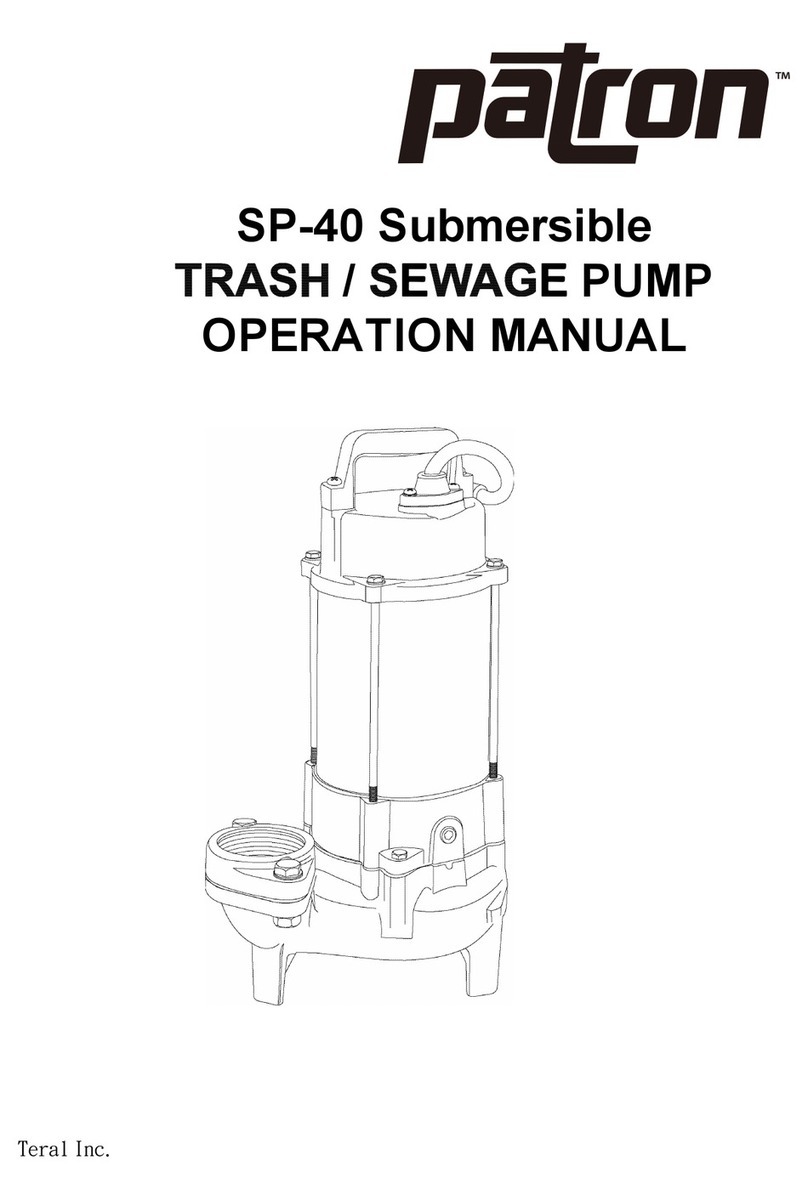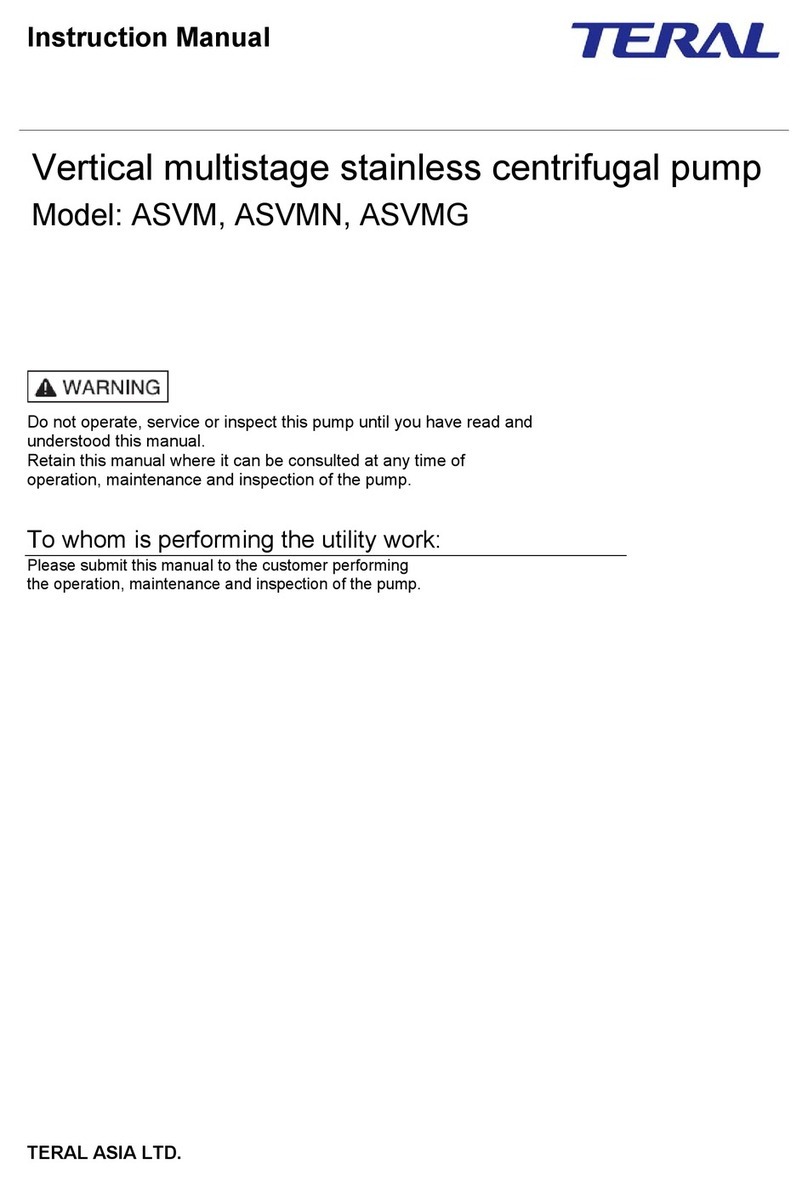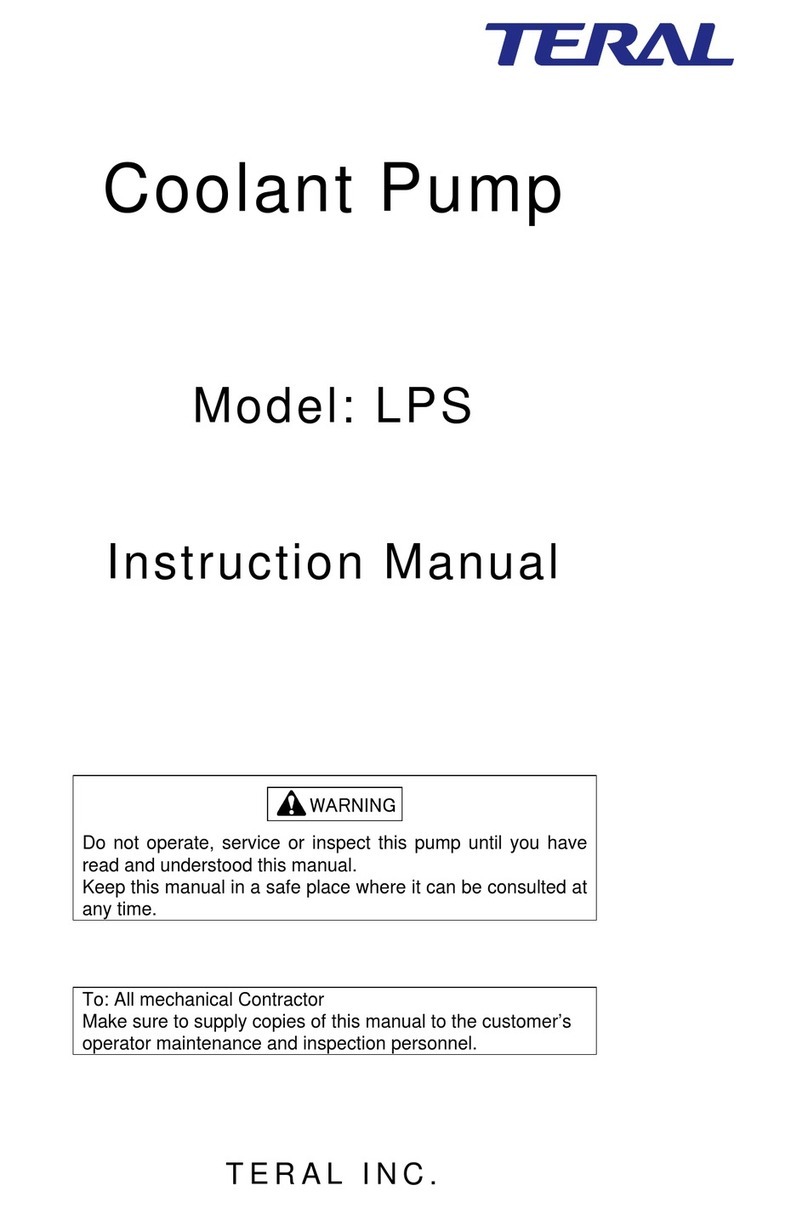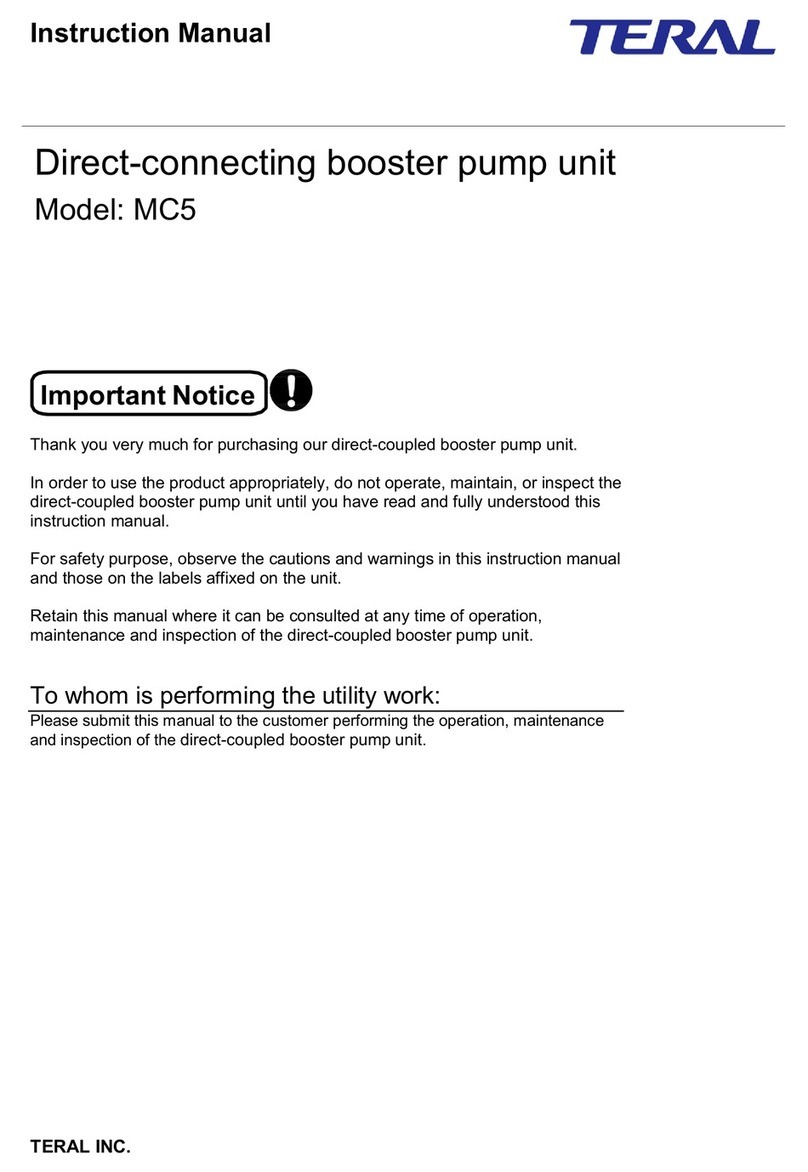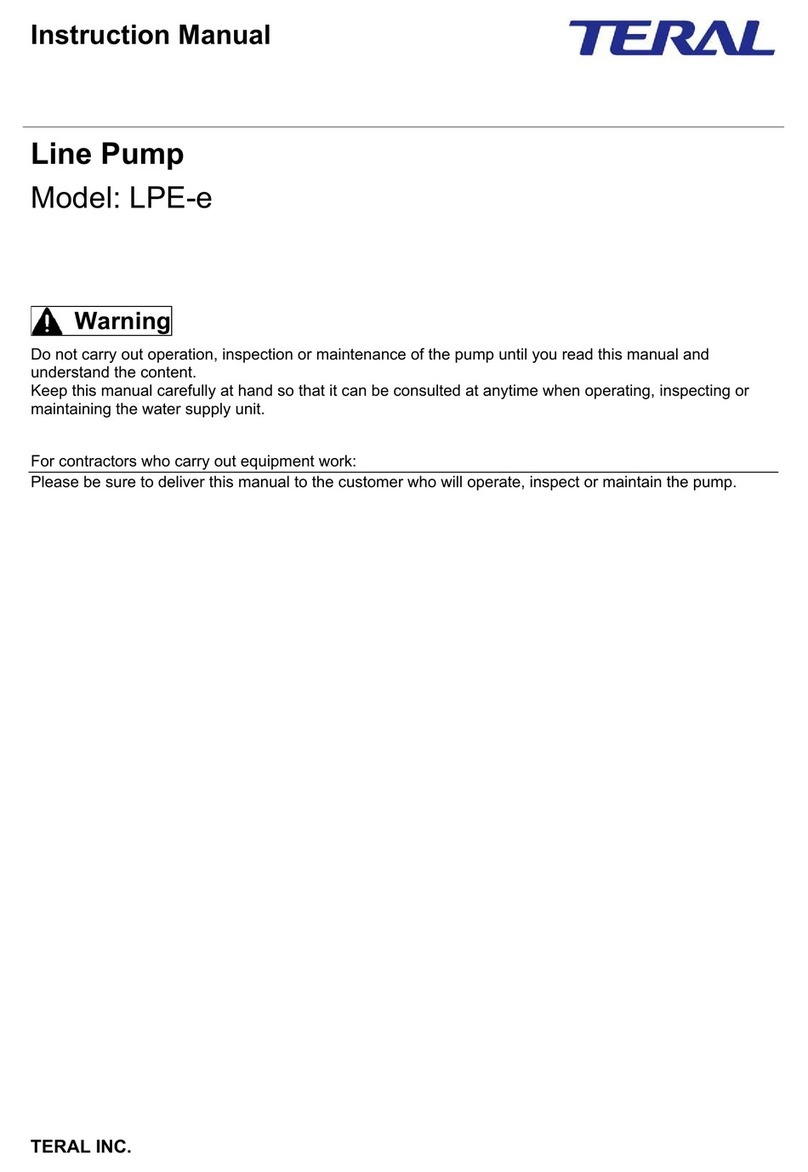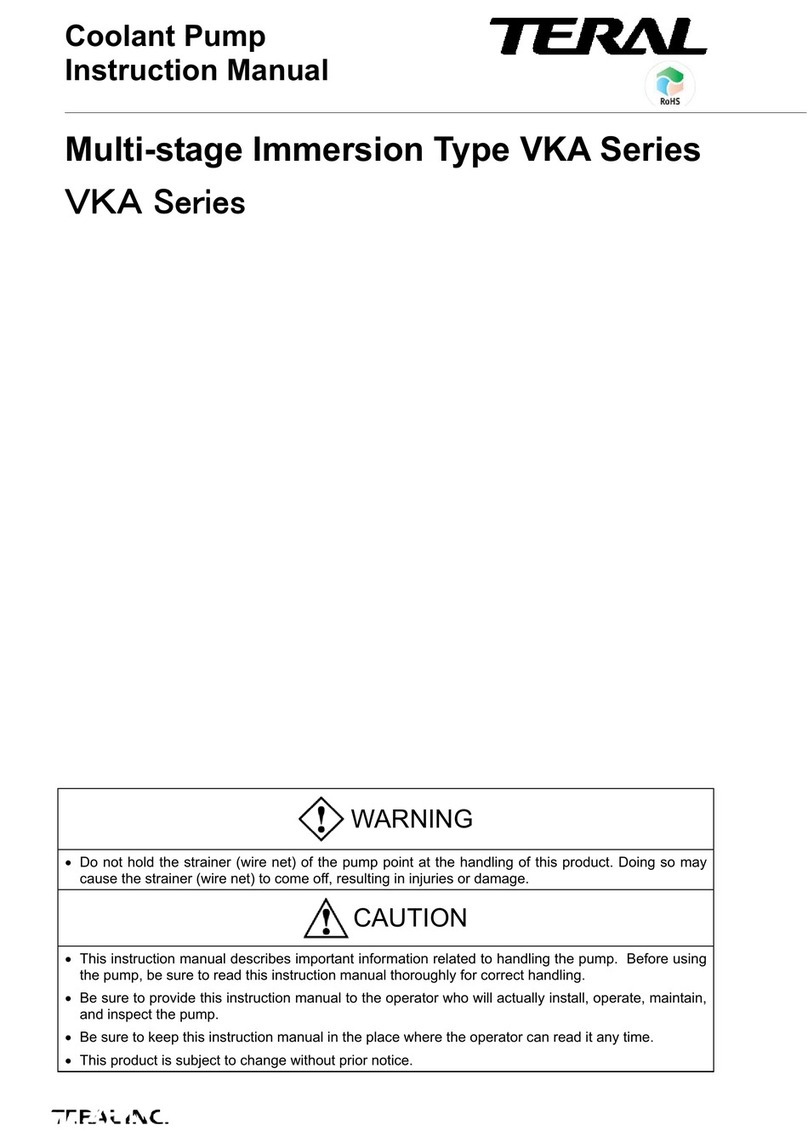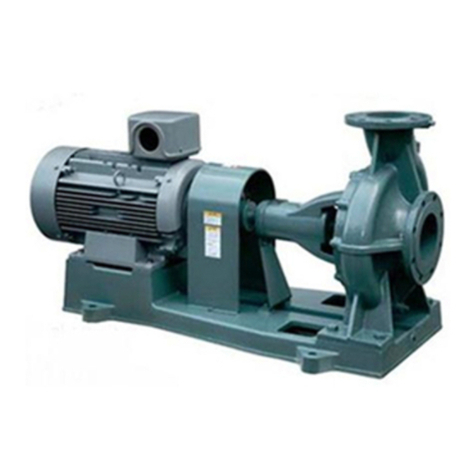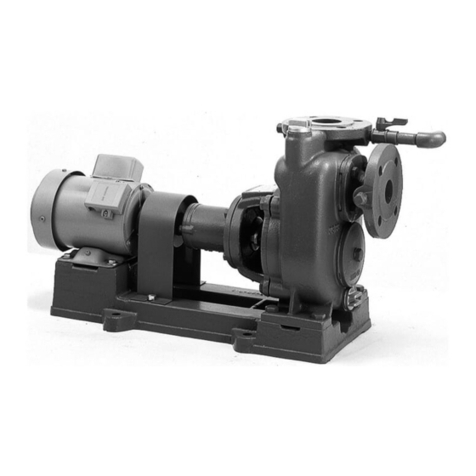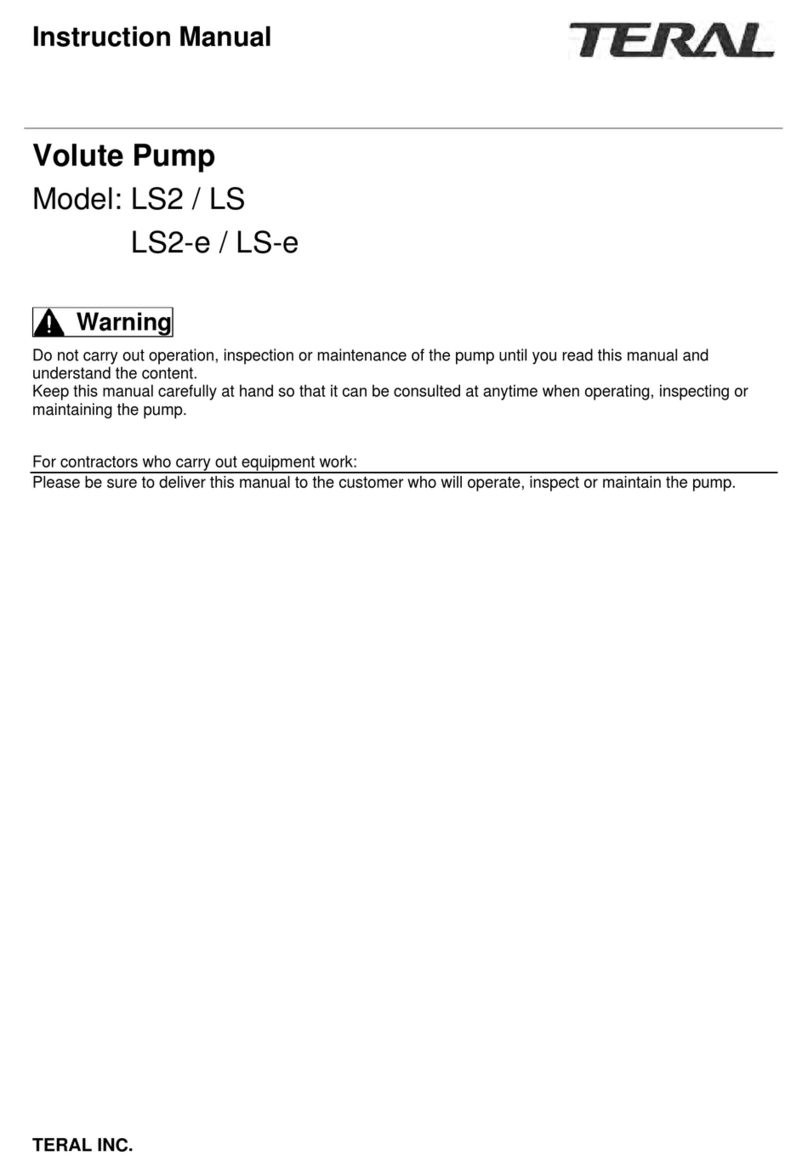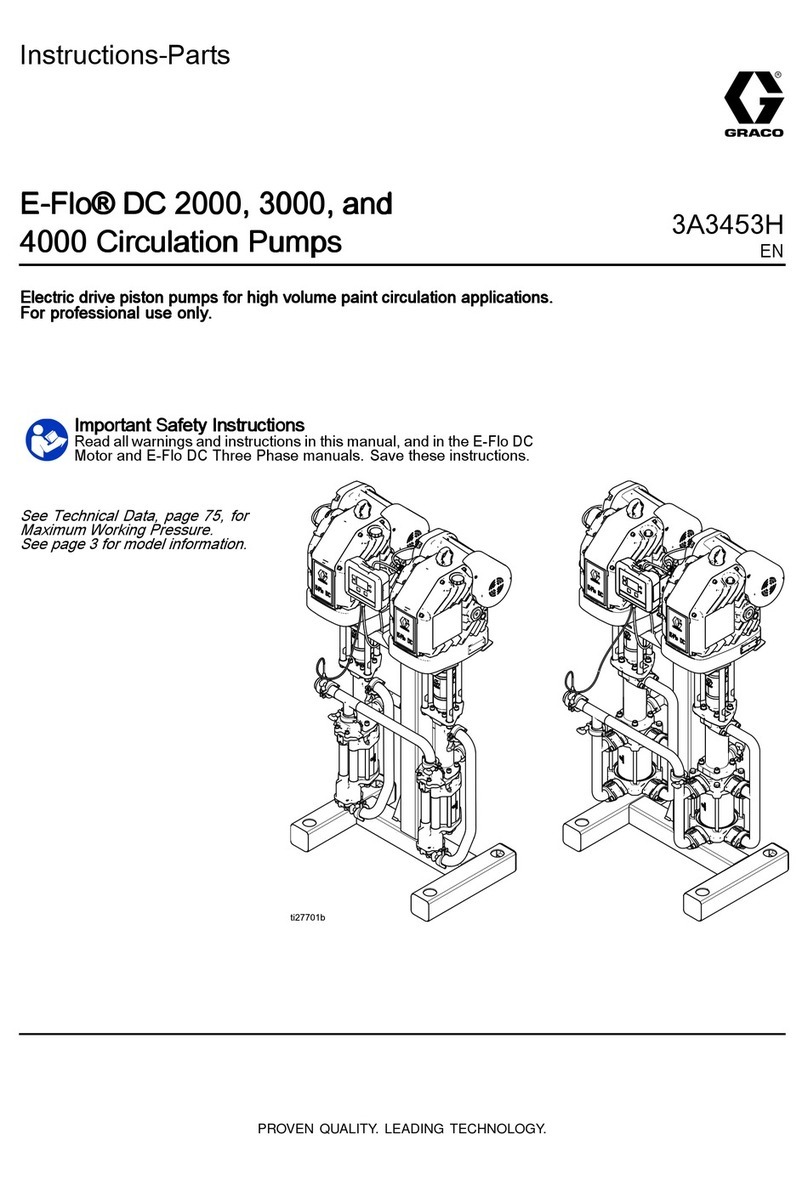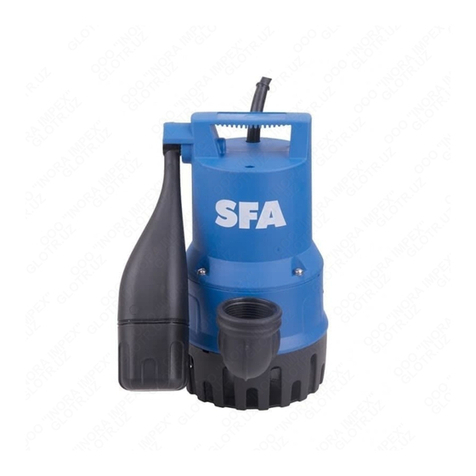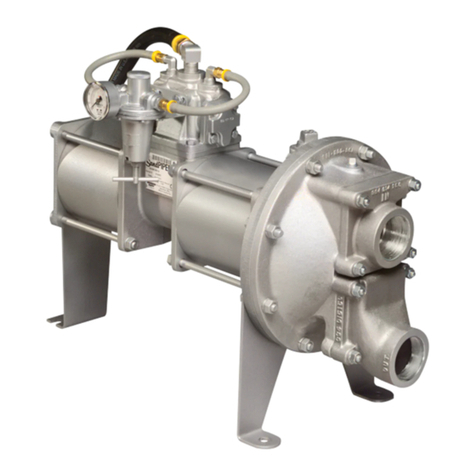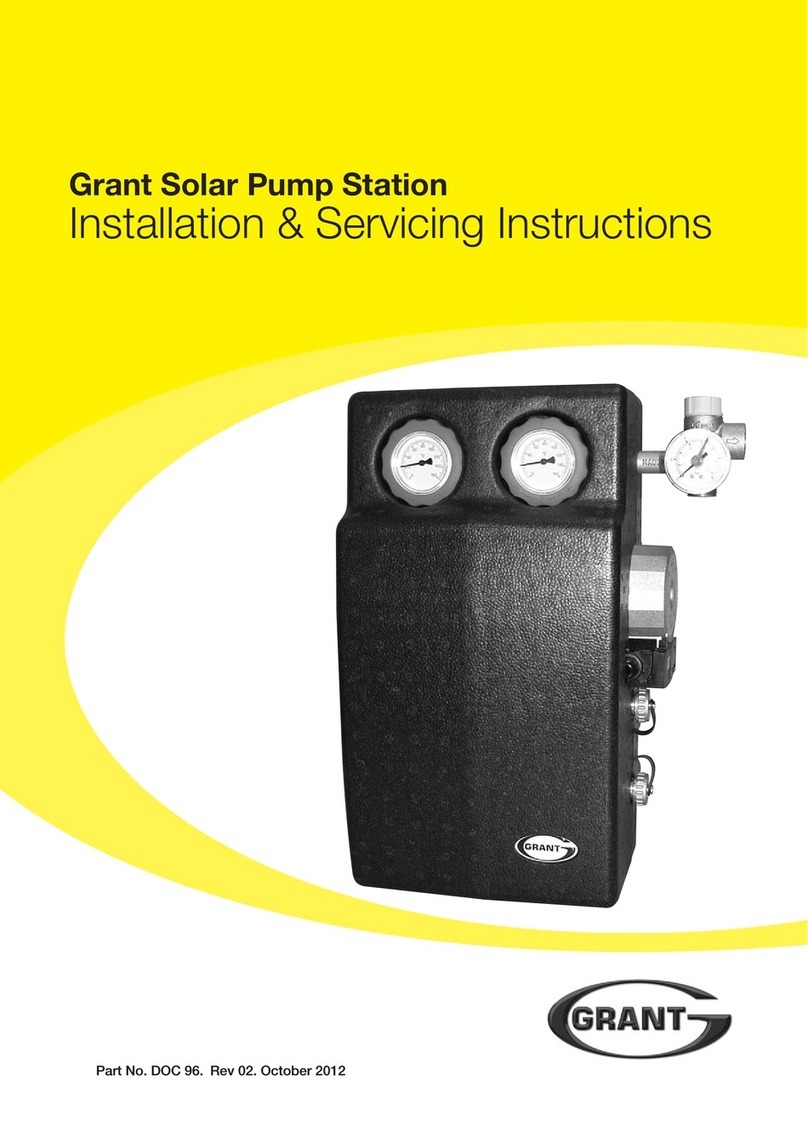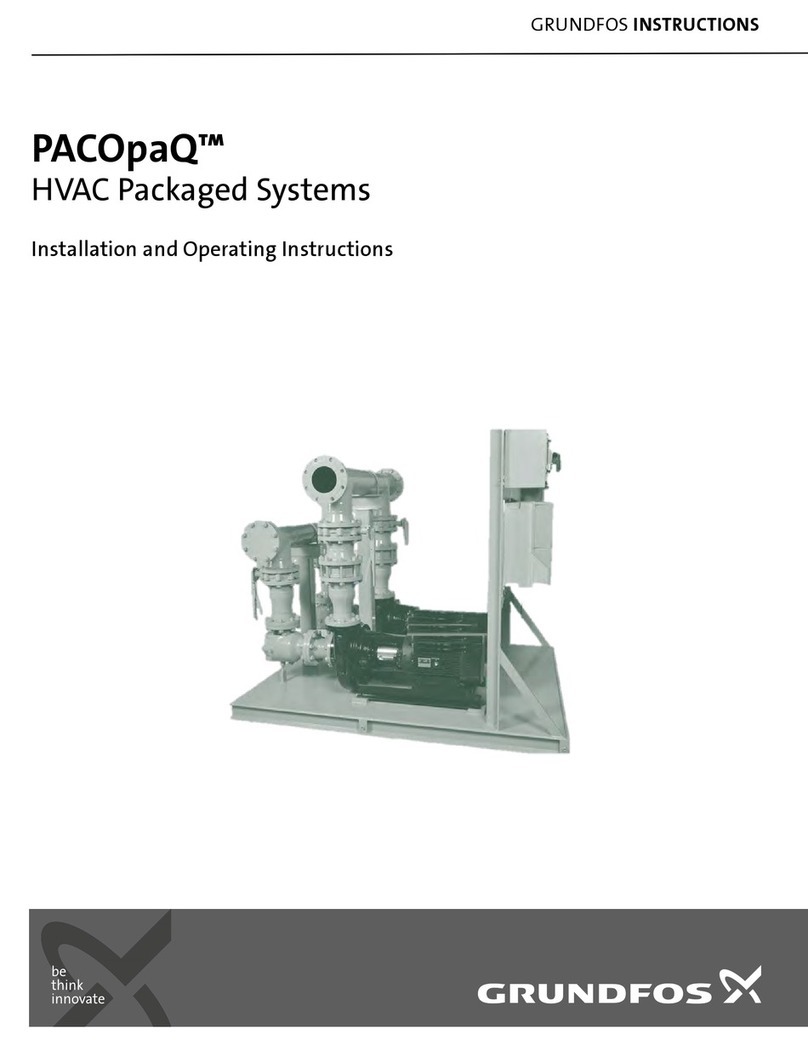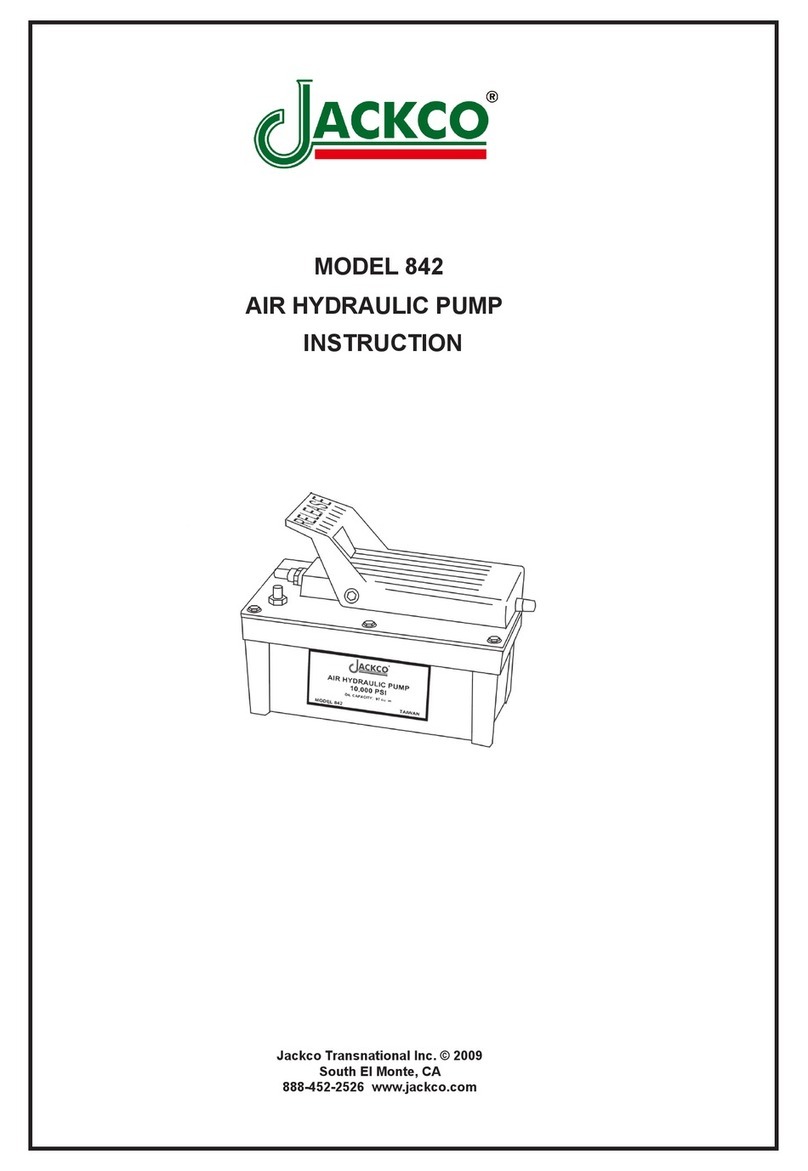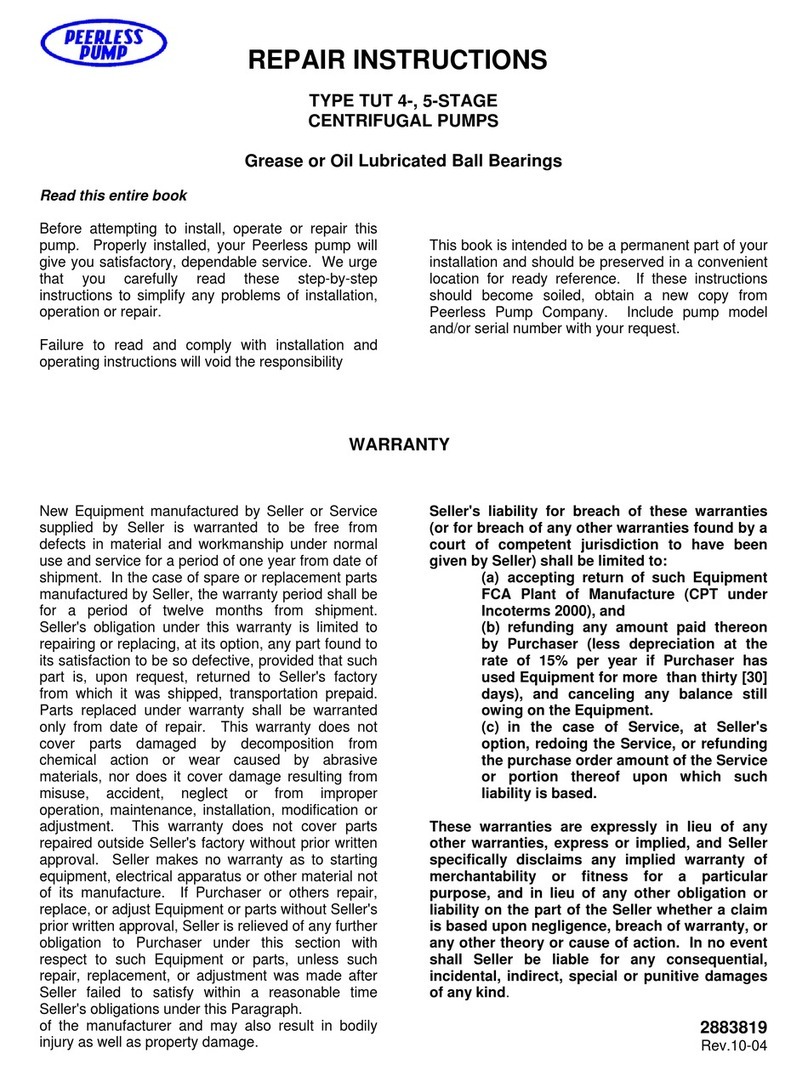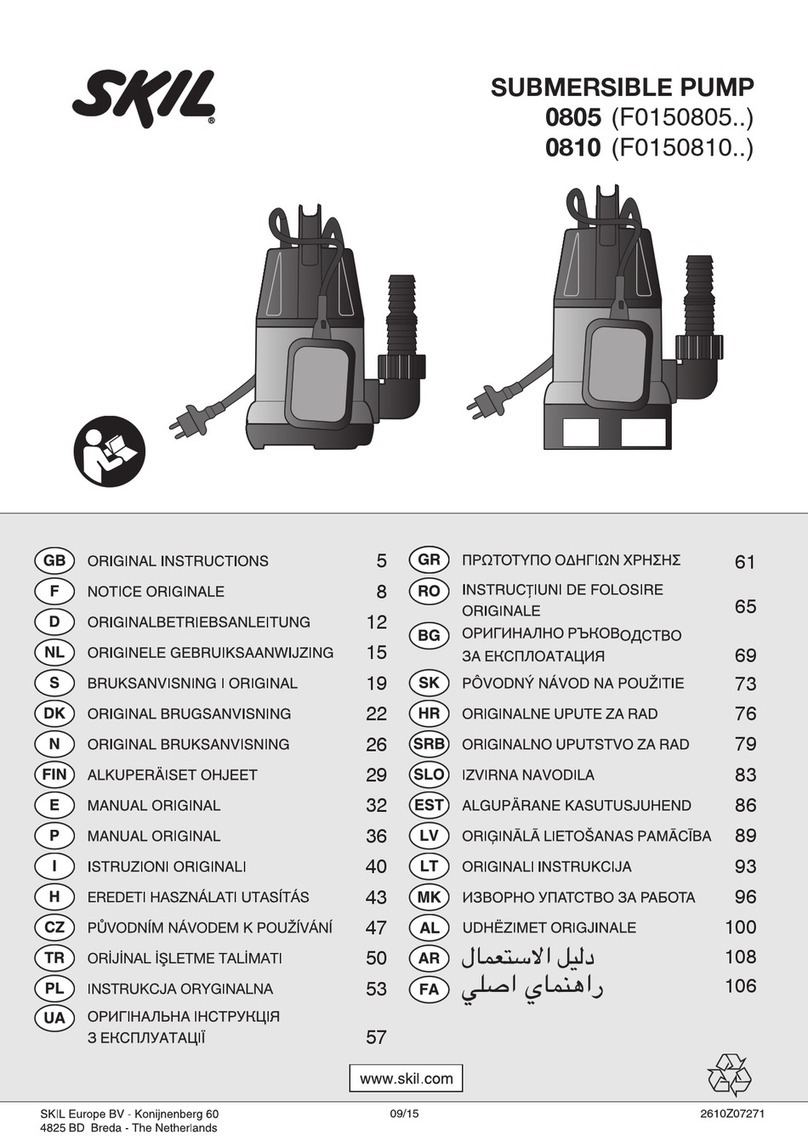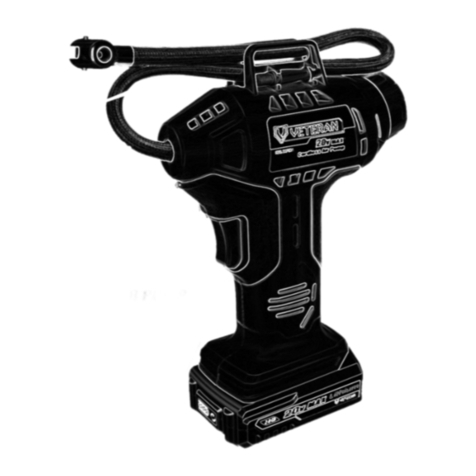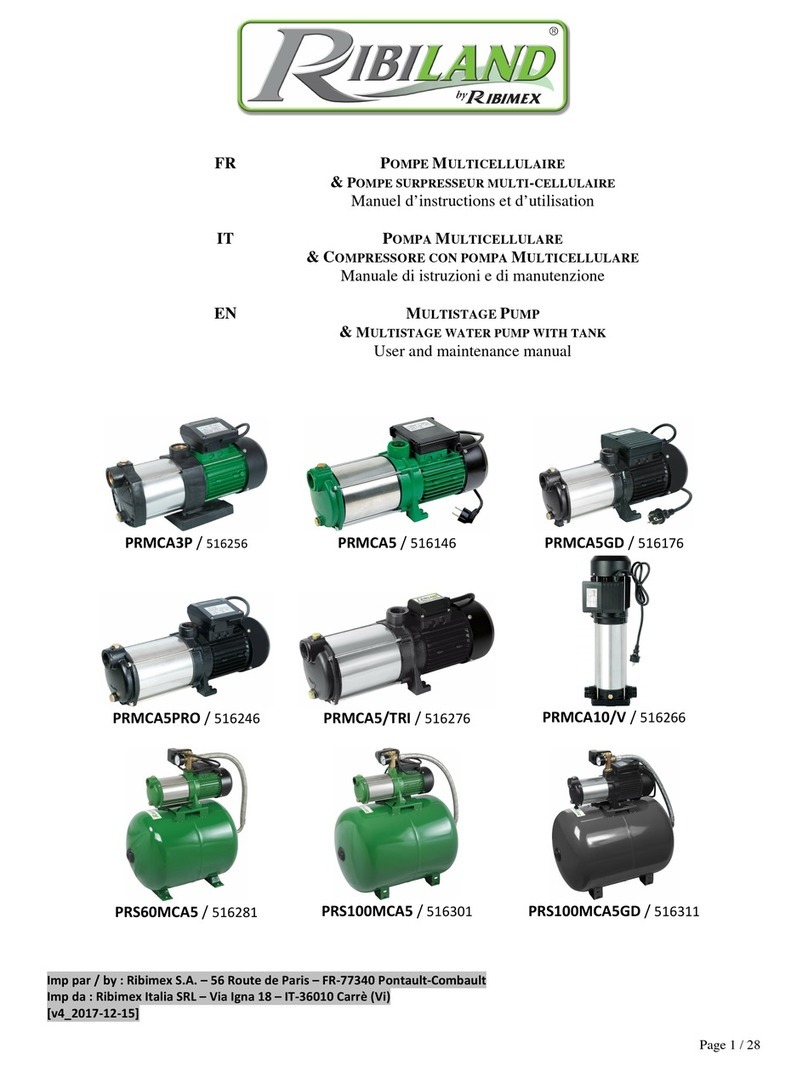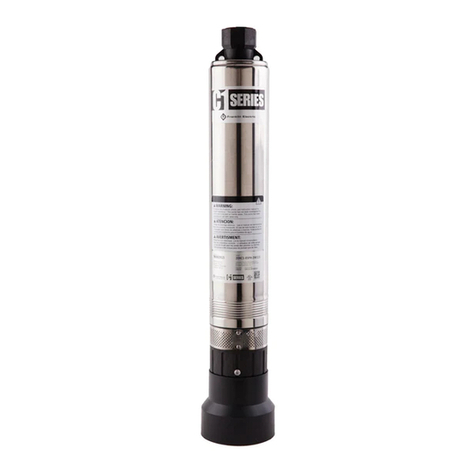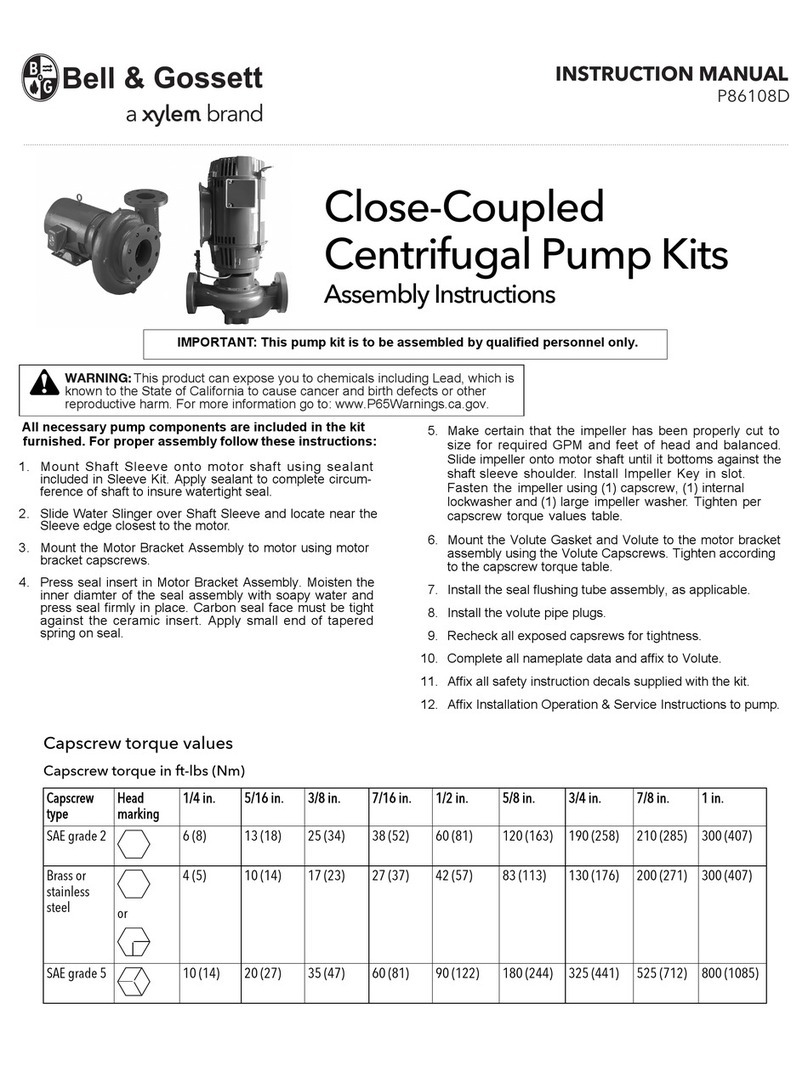Teral LHW-e User manual

Model : LHW-e/LPW-e/LPW-7W/ LKW-e
LFE/LFE-e
Coolant Pump
Coolant Pump
Instruction Manual

I
Limited warranties
1. In the event of a failure or breakage under proper use of the product during the warranty period,
equipment supplied by Teral Inc. shall be repaired or replaced free of charge within the scope of the
relevant part, provided that such failure or breakage is attributable to inadequacy of the design or
workmanship of the equipment.
The warranty period of this product shall be one year after the date of delivery.
2. The warranty mentioned in the above clause shall be only the mechanical warranty of the defective part,
and shall not cover any expenses or other damage arising from the failure or breakage.
3. In the event of the following failures and breakage, the costs of the repairs shall be borne by the user.
(1) Failures and breakage attributable to equipment that was not delivered by Teral Inc.
(2) Failures and breakage after the expiration of the warranty period
(3) Failures and breakage caused by disasters or force majeure, such as fire, acts of God, or
earthquakes
(4) Failures and breakage resulting from repairs or modifications made without the consent of Teral
Inc.
(5) Failures and breakage when parts other than those designated by Teral Inc. are used
(6) Failures and breakage caused by use or storage outside the specification range
4. Teral Inc. shall not be liable for the damage caused by incorrect or reckless use of the pump. Cost and
expenses incurred for sending engineer(s) in such a case shall be borne by the user.
5. If the cause of the failure is unclear, necessary actions shall be determined through mutual
consultation.
<Chargeable repair>
Investigation and repair work after the warranty period shall become chargeable. For any failures that have
occurred within the warranty period but that fall outside the above-mentioned warranty coverage, Teral Inc.
shall carry out repairs and investigation for a fee.

II
Purpose of this manual
The purpose of this manual is to provide the user with detailed information necessary to properly operate,
maintain and inspect the pump. Incorrect operation of this product may lead to an unexpected accident.
Please use the product correctly according to this instruction manual.
This manual contains the following information and is intended for persons experienced in the operation of
pumps, or for those who have been trained by such experienced operators. Only qualified personnel such
as licensed electrical engineers are allowed to carry out the electrical wiring work.
Contents (Page)
Limited warranties .................................................................................................................................... I
Purpose of this manual........................................................................................................................... II
Contents.................................................................................................................................................... II
1. Safety precautions...............................................................................................................................1-1
1.1 Types and meanings of safety signs and graphic symbols.........................................................1-1
1.2 Safety precautions.......................................................................................................................1-1
1.3 Location of warning labels and caution labels.............................................................................1-4
2. Configuration and overview of the pump.............................................................................................2-1
2.1 Part names and functions............................................................................................................2-1
2.2 Standard specifications ...............................................................................................................2-2
3. Installation ...........................................................................................................................................3-1
3.1 Before using the pump ................................................................................................................3-1
3.2 Precautions for installation..........................................................................................................3-1
3.3 Precautions for piping work.........................................................................................................3-4
3.4 Precautions for wiring work.........................................................................................................3-5
4. Operation.............................................................................................................................................4-1
4.1 Check items before test operation...............................................................................................4-1
4.1.1 Check items related to the electrical system.......................................................................4-1
4.1.2 Check items related to the pump.........................................................................................4-1
4.2 Running the pump (test operation)..............................................................................................4-2
5. Maintenance and inspection................................................................................................................5-1
5.1 Precautions for maintenance and inspection..............................................................................5-1
5.2 Replacement of the V-ring (for LPW65-e)...................................................................................5-2
5.3 Maintenance checklist.................................................................................................................5-4
6. Troubleshooting...................................................................................................................................6-1

1-1
1. Safety precautions
1.1 Types and meanings of safety signs and graphic symbols
This instruction manual divides precautions into the following four categories according to the level
of hazards (or the severity of the accident). In addition, prohibited or mandatory actions as well as
cautions are indicated with a graphic symbol.
Be sure to understand the meanings of the following terms and comply with the content
(instructions) of the instruction manual.
Explanation of warnings Explanation of the graphic symbols
Safety sign Meaning
Don’ts Do not touch Do not
disassemble Do not touch
with wet
hand
Do not
expose to
water
Danger
Indicates an imminently hazardous
situation. Failure to observe this will
result in death or serious injury. These graphic symbols indicate prohibited actions (that
must NOT be done).
Warning
Indicates a potentially hazardous
situation. Failure to observe this will
result in death or serious injury.
Do’s
This graphic symbol indicates mandatory
actions (that must be done).
Caution
Indicates a potentially hazardous
situation. Failure to observe this will
result in minor or moderate injury or
property damage. Caution Electric
shock hazard Rotation
hazard Hot surface
Note
Indicates information that is in
particular to be noted or emphasized. These graphic symbols indicate existing hazards to
beware of.
1.2 Safety precautions
Danger
Once the main power is turned on, do not touch any live parts.
A high voltage applied to live parts may cause a serious electric shock, thus leading to death.
Do not use the product in any explosive atmosphere.
Otherwise, it may lead to an injury or fire.
Warning
Properly move the unit according to lifting
instructions.
Otherwise, the unit may fall, thus leading to an injury or
damage.
Do not carry out any work with/on the pump that is
being lifted.
Otherwise, the unit may fall, thus leading to an injury or
damage.
Only those who are authorized by the site manager
are allowed to operate the pump.
Operation by unskilled personnel may lead to an unforeseen
accident.
Installation, maintenance, and inspection must
only be carried out by personnel who have been
trained to handle the pump.
Operation by unskilled personnel may lead to an unforeseen
accident.
Only qualified personnel, such as licensed electrical
engineers, are allowed to carry out electric work.
Otherwise, it may lead to an electric shock, fire, failure, or
other problems.
Use high-quality wiring equipment and devices,
and carry out wiring work safely and securely
according to the technical standards for electrical
facilities, as well as the indoor wiring regulations.
Otherwise, it may lead to an electric shock, fire, or other
problems.
Do not connect the ground wire to a gas pipe or
water pipe.
Such a connection is illegal and leads to an electric shock,
explosion, or fire.
Securely install the ground wire and ensure to
carry out grounding work.
Otherwise, it may lead to an electric leak or electric shock.
Do not run the unit if abnormal condition is observed
in any operation, movement, parts, etc.
Otherwise, it may lead to an injury, failure, or various
accidents.
Correctly and securely connect the wires
according to the wiring diagram within the terminal
box and the instruction manual.
Incorrect wiring may cause a fire, electric shock, failure, or
other problems.

1-2
Warning
Be sure to keep the terminal box cover attached
during the operation of the pump.
Otherwise, it may lead to an electric shock.
Be sure to install the coupling cover during the
operation of the pump.
Otherwise, it may lead to an injury or damage.
After detaching the companion flange from the
pump, screw a pipe into it.
Otherwise, it may lead to damage or leakage.
Do not forcibly bend, pull, or pinch the power cable
or any lead wires of the product.
Otherwise, it may lead to an electric shock or fire.
Check the wiring sections and wires for any
looseness.
A loose connection may cause a fire or electric shock.
Before starting the maintenance or inspection
work, be sure to stop the pump and turn off the
main power of the panel board.
Otherwise, it may lead to an electric shock, injury, damage,
or leakage.
Before starting the unit or carrying out
maintenance/inspection work, ensure that all the
relevant workers are informed of the operation and
that there are no workers in the dangerous zone.
Otherwise, it may lead to an unforeseen accident.
Before rotating the main shaft by hand to check its
smooth rotation, be sure to turn off the main power.
Otherwise, it may lead to an injury or damage.
After turning on the power, do not touch any parts of
the pump other than those required for operation.
Otherwise, it may lead to an electric shock or injury.
Do not perform long hours of zero-discharge
operation continuously.
Otherwise, the temperature and pressure may increase
inside the pump, thus damaging the pump or causing steam
to blow off.
Do not put your fingers or foreign objects into any
openings or rotating part of the motor during
operation.
Otherwise, it may lead to an injury or damage.
For overhaul, replacement of parts, or repairs, ask
the vendor or the service center specified by Teral.
If unskilled personnel carry out work that requires special
knowledge, it may lead to an accident or failure.
In the event of a power failure, be sure to turn off the
power switch.
Otherwise, the pump may suddenly start up on restoration of
the power, thus leading to an injury.
Caution
Do not use the unit outside the range of the product
specifications.
Otherwise, it may lead to an electric shock, fire, leakage,
failure, or other problems.
Do not use the unit at an incorrect power voltage.
An incorrect voltage may damage the motor.
Do not use a single pump unit as the only means of
directly operating key facilities or sustaining life.
In the event of a failure, the water supply may stop. Ensure to
make a backup unit available for operation.
Before unpacking the delivered container, check
that the container is placed in the correct
orientation (not upside down). Carefully unpack the
container, while paying special attention to nails.
Otherwise, it may lead to an injury or damage.
Ensure that the floor at the unit’s installation place is
waterproofed and fitted with drainage.
Otherwise, it may lead to serious damage in the event of
leakage.
Do not install two or more different cables or
control wires in one pipe or duct.
Otherwise, it may lead to malfunction of the product or other
equipment.
Do not step on the pump or motor.
Otherwise, it may lead to an injury, damage, or other problems. Do not expose the motor to water.
Otherwise, it may lead to an electric shock, electric leak,
failure, or other problems.
Operate the controls carefully.
Otherwise, it may lead to an injury or damage. Never run the pump dry.
Otherwise, it may lead to damage or a fire.
Before operation, thoroughly clean (flush) the inside
of the piping to remove foreign matter.
Otherwise, the piping system may be contaminated with
foreign matter, thus leading to an accident or a pump failure.

1-3
Caution
Do not put a cloth or other covering on the motor.
Otherwise, it may lead to overheating or ignition. Do not touch the motor body while the pump is
running or immediately after the pump has stopped.
Otherwise, you may get burns from the hot surface.
In the event of an alarm or abnormal condition that
cannot be resolved, immediately stop the
operation, turn off the power, and then contact Teral
or its service provider.
Otherwise, it may lead to an accident.
Do not run the pump with tools or other objects
placed on the unit.
Otherwise, it may lead to an injury or damage.
Check that the delivered items are exactly what you
ordered.
The use of a wrong product may cause an injury or failure.
Do not hold the strainer located on the tip of the
pump.
Otherwise, the strainer may come off, thus leading to an injury
or damage.
Do not place any obstacles around the product that
may hinder ventilation.
Otherwise, it may lead to a fire.
Do not place any combustibles around the product.
Otherwise, it may lead to a fire.
Do not run the pump at a frequency exceeding 60
Hz (50 Hz for models dedicated to 50Hz).
Otherwise, it may lead to motor burnout or a fire.
Do not touch the impeller, tie bolt, strainer, or other
parts of the pump with bare hands.
Otherwise, it may lead to an injury or damage.
Ensure to install an overcurrent protective device.
The user is required by the technical standards for electrical
facilities to install one. Otherwise, it may damage the product,
thus leading to a fire or failure. It is also recommended to
install protective devices such as a ground fault interrupter.
Do not use the unit for pumping any fluids beyond
the specified viscosity limit.
Otherwise, it may lead to motor burnout or a fire.
Do not run the pump with its strainer removed.
Otherwise, it may lead to an injury or damage.
Do not touch any terminals or wires when
measuring the insulation resistance.
Otherwise, it may lead to an electric shock.
Do not touch the Impeller after removing the
strainer.
Otherwise, it may lead to an injury.
Once you turn off the power, wait until the pump
stops completely. Do not restart the pump until it
does.
Otherwise, the main shaft may be subjected to an excessive
load, which makes the service life of the pump shorter.
Do not use thinner or benzine for cleaning the
product.
Otherwise, the product may be discolored or its coating may
be peeled off.
If you use a solvent for cleaning the product, pay
attention to handling of the solvent as well as the
environment of use.
Otherwise, it may lead to poisoning.
When you lift the product, pay attention to its center
of gravity.
Otherwise, the product may topple over or fall, thus leading to
an injury.
Dispose of the product as industrial waste.
Be sure to conduct inspection according to the
Maintenance checklist.
Otherwise, you cannot prevent potential failures, thus leading
to a higher risk of accidents.
When you lift the product by hand, pay attention to
its weight. Do not allow a single person to lift a
product heavier than 15 kg.
Otherwise, it may put strain on the body, thus leading to an
injury.
Do not put your fingers or foreign objects into the
immersion detecting hole.
Failure to observe this may lead to an injury or
damage.

1-4
Motor name plate
1.3 Location of warning labels and caution labels
The figure shows the locations of warning labels and caution labels. If these labels become dirty and
illegible or if they are peeled off, replace them with a new one.
Warning
Caution
Observe all the warnings and cautions affixed to
the machine as well as those described in this
instruction manual.

2-1
2. Configuration and overview of the pump
This chapter describes the standard specifications of the pump. If you have purchased a customized
product, some information in this chapter may not be applicable to your unit. Refer to the delivery
specifications for the details separately.
Caution
Do not use this product under any conditions other than those
provided in the specifications. Otherwise, it may lead to an electric
shock, fire, leakage, or failure.
2.1 Part names and functions
Motor
Discharge port
Suction port (with strainer)
Air vent valve
If air cannot be released from the pump to the
atmosphere on the discharge piping, you can
discharge air using this valve to prevent dry
running.
Immersion detecting hole (LHW-e, LKW-e,
LPW40/50-e,LPW40/50-7W)
If liquid leakage occurred from the immersion
detecting hole, check the shaft sealing part.
Coupling (LPW65-e)
Coupling cover (LPW65-e)
Warning
Caution
Be sure to keep the coupling cover and the strainer attached during
the operation of the pump. Failure to observe this may lead to an
injury.
Caution
Do not put your fingers or foreign objects into the immersion
detecting hole. Failure to observe this may lead to an injury or
damage.
※
The appearance is different according to the model.
Representing model
(The drawing shows LPW40-e) LPW65-e

2-2
2.2 Standard specifications
If you have purchased our standard product, refer to the “Standard specifications” table. If you have also
purchased a customized product with special specifications, refer to the delivery specifications.
・Standard specifications
Model※1LHW-e LKW-e LFE/LFE-e LPW-e LPW-7W
Nominal diameter(mm) 20 20 32/50/65 40/50/65 40/50
LPW40:Water-soluble coolant, liquids
of similar viscosity to water containing
additives (anti-rust agents) and the
like (up to 32 mm2/s for LPW40C, up
to 150 mm2/s for LPW40D※2)
Quality Water-soluble coolant
(dynamic viscosity 1mm2/s)
LPW50/65:Water-soluble coolant
Applicable
liquid
Temperature 0 to 60 °C (No frozen liquid is allowed.)
Installation location
Indoors; height above sea level: 1,000 m or less; ambient temperature: 0 to
40°C; humidity: less than RH85% (no condensing); place not exposed to direct
sunlight; place without any corrosive gas, explosive gas, or vapor in the
atmosphere
Suction casing
(Suction cover)
Discharge casing FC200 FC200 FC200 FC200
Intermediate
casing ARLS ARLS
+(SUS304) - FC200
Impeller ARLS ARLS FCD450 FCD450
Motor Equivalent
to
SUS420J2 S35C S35C LPW40/50:S45C
Material
Main
shaft Pump - LPW65:S45C
Shaft sealing structure Sealless structure(without mechanical seal)
Type Totally-enclosed fan-cooled indoor type
IP protection IP44 LPW40/50:IP44
LPW65:IP55 IP54
Power※33-phase
50/60Hz
200/200-220V
3-phase
60Hz
200-220V
3-phase
50/60Hz
200/200-220V
3-phase
60Hz
208-230/460V
Insulation
class Class F
Motor
Number of poles
2P
Coating color Munsell N1.5
* 1 All the models that the suffix “-e” is appended to the model name are the products with a built-in
premium efficiency (IE3-equivalent) motor.All the models that the suffix “-7W” is appended to the
model name are the products with a built-in UL standard motor.
* 2 Note that the product can be used for the water containing additives (anti-rust agents) such as
water-soluble or non water-soluble coolant, but cannot be used for water.
* 3 Limit the fluctuations of the power voltage within ±10% of the rated voltage, and also limit the
fluctuations of the frequency between –5% and +3% of the rated value. Avoid continuous
operation if the voltage is not within ±5% of the rated value or if the frequency is not within ±2% of
the rated value.
*

3-1
3. Installation
3.1 Before using the pump
Upon receiving the pump, check the following points first.
The container may greatly incline depending on its center of gravity.
Caution
Before unpacking the delivered container, ensure that the container is
placed in the correct orientation (not upside down). Pay special attention to
nails especially when opening a wooden crate. Otherwise, you may get
injured.
(1) Check the nameplate to verify that the delivered product is exactly what you ordered.
(2) No part of the product is damaged during transportation.
(3) All fastening parts including bolts and nuts are securely tightened.
(4) All the accessories that you ordered have been delivered. (Note that the direct operation type
contains the pump and the accessories such as bed in separate packages.)
Warning
Do not hold the strainer on tip of the pump during handling. Failure to
observe this may cause the strainer to come off, resulting in an injury or
damage.
Caution
When lifting the product by hand, pay attention to its center of gravity and
weight. Do not allow a single person to lift a product heavier than 15 kg.
Failure to observe this may cause the burden on the body, resulting in an
injury.
Caution
Do not run the pump at a frequency exceeding 60 Hz (50 Hz for models
dedicated to 50Hz). Failure to observe this may cause an overload and
burnout of the motor.
3.2 Precautions for installation
(1) Install the product in a well-ventilated place with minimum exposure to dust and moisture. In
particular, avoid installing the product in a place where the pumping liquid may be splashed on the
motor section.
Warning
Do not install the product in a place exposed to high temperature and
moisture.
Failure to observe this may cause heating, ignition or electric leakage.
(2) Install the product so that the motor can take air in.
(3) Securely install the product on a flat place without any wobbles.

3-2
(4) Select a convenient place to conduct maintenance and inspection. Secure space for
maintenance.
(5) It is necessary to make a mounting hole larger than the outside diameter of the pump section so
that the pump section can fit into the tank (oil tank). See the dimensional outline drawing.
(6) Install the pump so that the main shaft becomes vertical.
(7) Use the product with the pump section immersed under the oil level. The suction port should be at
least t mm away from the bottom surface of the tank (oil tank) to prevent the strainer from getting
clogged with cutting powder, dirt, or other materials. If cutting powder, dirt, or other materials are
predicted to accumulate on the bottom of the tank, ensure as large a distance as possible from the
bottom at the design stage. Model h t
LHW-e 45 5
LPW40-e(-7W) 65 25
LPW50Z-e 51 25
LPW50ZL-e(-7W) 36 20
LPW65-e 100 50
LKW-e 45 5
LFE32/LFE32-e 60 20
LFE50/LFE50-e 75 20
LFE65-e 100 20
(8) For model LKW-D-e, refer to the drawing below
and assemble the pump main body and
accessories such as bed.
Note
Always keep the liquid level in the tank (oil
tank) above the Minimum liquid level.
Keep the suction port of the pump at least t
mm away from the bottom of the tank (oil
tank), and at least 5 mm away for LKW-D-e
(series operation).
All
models In case that pipes and a strainer
are installed (except for LHW-e)
LKW-D-e
Discharge
Bed
Bush 11/4x3/4B
Street elbow 3/4B
Flexible hose 20Ax500L
Tank
bottom
Min. liquid
level
Suction
No.1
pump
No.2
pump
At least
5mm

3-3
(9) Install the product at a place where a secondary hazard does not occur in the event of any liquid
leak.
(10) If the system could be exposed to the freezing temperature in winter, be sure to apply antifreeze
measures such as heat insulation and heater installation to the pump, valves, piping, etc.
(11) Securely install the pump.
Note
Securely fix the pump in place with the bolts. Otherwise, it may lead to
abnormal vibration or other problems.
(12) To lift the pump, pass a rope or the like through the hanging hole of a casing for the model LHW-e,
LPW40/50-e, LPW40/50-7W and pass a rope or the like through the eyebolt of motor for LPW65-e,
LKW-e, LFE/LFE-e. Do not lift he equipment with the pump attached. Failure to observe this may
cause the equipment to break and fall down.
(13) Use extreme care so as not to give an impact or offset load to the pump section during pump
lifting or conveyance. The pump may greatly tilt depending on its center of gravity.
Warning
Before lifting the pump, refer to the catalog, dimensional outline drawing,
and other documents to check the weight of the units. Do not lift any units if
its weight exceeds the rated load of the hoisting equipment/devices.
Caution
When lifting the pump by hand, pay attention to its center of gravity and
weight. Do not allow a single person to lift a product heavier than 15kg.
Otherwise, the pump may topple over or fall, thus leading to an injury.
(14) If the pumping liquid is cold, condensation may occur inside the motor while the pump is stopped.
Take measures to prevent condensation, for example, by installing the pump in a sufficiently dry
room or by heating and insulating the motor even when the pump is stopped.
(15) Carry out touchup painting at a time interval suitable for the environment of use. Depending on the
humidity, condensation, and other conditions, rust may form on areas such as threaded parts,
worked areas, anticorrosive-coated sections.
(16) Do not put a cover or filter over the motor. Otherwise, the temperature may increase inside the
motor, thus leading to product damage, fire, or other problems.

3-4
3.3 Precautions for piping work
(1) The pipes must be as short and straight as possible with minimal joints and valves. Use pipes
whose bore size is equal to or larger than the discharge port of the pump. If the piping size is small
or there are many bends, the discharge rate may become low.
(2) Ensure to provide adequate pipe supports so that the weight of the piping system will not be
applied directly to the pump body.
Caution
Do not allow the weight of the pipes to rest on the pump.
Failure to observe this may cause the main shaft from coming off center,
resulting in equipment damage, vibration, and noise.
(3) Do not forcibly screw a pipe into the pump. Otherwise, it may break the joint.
(4) Securely connect the pipes so that the connections are kept completely airtight without leakage.
Prevent leaks of liquid and air with seal tape, liquid packing, or other means. Firmly wind the seal
tape while paying attention not to block the piping.
(5) Use a tank (oil tank) with as large a capacity as possible.
* It is recommended to use a capacity of at least three times the discharge volume per minute.
Too small a capacity may cause problems such as the rise of liquid temperature, premature
strainer clogging with cutting powder, and lower discharge rate caused by bubbles.
When pouring a pumping liquid into a tank (oil tank), gently pour it so as not to trap air in.
(6) Do not allow a large amount of cutting powder, dirt, or other contaminants from entering the pump
section. Failure to observe this may clog the pump strainer, damage the pump, or significantly
deteriorate the performance. Before using the coolant pumps, implement the treatment of liquid
through a net cage, a chip conveyor, a magnetic separator, etc as per the table below.
Pumps that can be used after primary treatment LPW-e,LPW-7W
Pumps that can be used after secondary treatment All models
(7) If water hammer may occur, attach a pressure damper (e.g. accumulator).
(8) The pump is packaged with a companion flange for the discharge port. Use it as needed. When
using the flange, be sure to install the supplied O-ring.
(9) If there is an upward curve on the discharge pipe, ensure that air can be vented from the section.
(10) If you provide a relief pipe on the discharge side of the pump, also provide a sluice valve in the
middle of the relief pipe to adjust the relief volume.
Note
If the amount of liquid released from the relief pipe is too much, the liquid
temperature easily rises in the tank (oil tank).
(11) On completion of the piping work, be sure to clean the tank (oil tank) to prevent the suction of
foreign matter.

3-5
3.4 Precautions for wiring work
Danger
Use high-quality wiring equipment and devices, and carry out wiring work
safely and securely according to the technical standards for electrical
facilities, as well as the indoor wiring regulations.
Only qualified personnel such as licensed electrical engineers are allowed
to carry out electrical wiring work. Unqualified persons are prohibited by
law to carry out wiring work, and it is very dangerous.
Danger
Securely connect the terminals of the power cable. Loose terminals may
cause the motor to run in open-phase condition, thus leading to motor
burnout.
(1) Be sure to install a ground fault interrupter and an overload protection device on the primary
power side of the pump.
* The starting current of Top Runner efficiency (equivalent to IE3) motor and UL standard
motor-equipped products tends to become higher than that of standard efficiency (IE1)
motor-equipped products. Therefore, when switching from an IE1 motor-equipped product, it is
necessary to verify the applicability of its ground fault interrupter and overload protection device. If
you have any questions, contact your nearest office of Teral.
Note
When switching from an IE1 motor-equipped product, it is necessary to
verify the applicability of its protection device on the primary side of the
pump.
Failure to observe this may cause the protective device to trip on startup.
(2) When connecting to terminals, securely connect to the power according to the below figure.

3-6
(3) Be sure to attach a ground wire to prevent an electric shock.
Connect the ground wire to the ground terminal inside the terminal box of the motor.
Warning
Connecting a ground wire to gas or water pipes is illegal and extremely
dangerous.
(4) To prevent the terminal block and power cable of the motor from being pulled, fasten the power
cable to the terminal box with the cable lock.
Warning
Do not change the orientation of the terminal box.
Failure to observe this may cause the liquid to entering the terminal box,
thus leading to an electric shock.
(5) To prevent overload and burnout of the motor, it is recommended to use a thermal relay for motor
protection.
(6) Carry out adequate dust-proofing and drip-proofing using a connector or gland so that cutting
powder and liquid coolant do not enter the terminal box through the external wiring hole.
(7) Pass the power cable through a metal tube or a metal conduit for shielding, and connect a ground
wire to the outer surface of the tube.
(8) Limit the fluctuations of the supply voltage within ±10% of the rated voltage, and also limit the
fluctuations of the frequency between –5% and +3% of the rated value. Although you can run the
pump in these ranges, avoid continuous operation if the voltage is not within ±5% of the rated
value or if the frequency is not within ±2% of the rated value. Otherwise, it may overload the pump,
thus leading to motor damage or a fire.
Even if the power fluctuations fall within the allowable ranges, the pump characteristics, motor
characteristics, and the temperature rise of the motor may differ from those at the rated voltage
and frequency.
(9) For direct operation type, set the circuit so that the pumps starts from No.1 then No.2 (or together)
and stops from No.2 then No.1 (or together).

3-7
Warning
Never start the operation with No. 2 pump nor operate No.2 pump only; it
will cause idle operation, leading to the product damage.
(10) Precautions for using the inverter drive
• Ensure that the electric current during operation does not exceed 90% of the rated value.
• Ensure that the minimum frequency is set to 20Hz.
(Contact us if you need to run the drive at 20Hz or lower.)
• When driving a 400V-class motor, contact Teral. In some cases it might be necessary to take
measures for inverter surge.
• An inverter-driven motor generates a magnetic sound which may be annoying compared with
the drives using commercial power supply. Although this magnetic sound does not cause an
adverse effect on the quality of the motor, some inverters allow the user to adjust the tone by
changing the carrier frequency. However, changing the frequency may reduce the allowable
output of the inverter. Pay particular attention when selecting the inverter.
• If the pump and motor produce resonance during normal operation, do not run them in the
range of the rotation speed.
Caution
Do not run the pump at a frequency exceeding 60 Hz (50 Hz for models
dedicated to 50Hz). Failure to observe this may overload the motor,
causing it to burnout. If the models dedicated to 60Hz are run at 50Hz, the
performance will deteriorate.
(11) For LPW65-e, be sure to connect the terminals of power cables in a reversed-phase (by
exchanging R with T of the power cables). If the terminals are connected in a positive phase, the
pump rotates in the reverse direction, which may cause damage. For the other models, connect
the terminals of power cables in a positive phase.
Caution
For LPW65-e, be sure to connect the terminals of power cables in a
reversed-phase (by exchanging R with T of the power cables). If the
terminals are connected in a positive phase, the pump rotates in the
reverse direction, which may cause damage.

4-1
4. Operation
4.1 Check items before test operation
4.1.1 Check items related to the electrical system
(1) Check that the equipment is correctly wired.
(2) Check that the terminals are securely connected.
(3) Check that the equipment is securely grounded.
(4) Check that the setup value of the overload protection device is consistent with the rated current
value of the motor.
(The rated current of pump should be included in the setting range of the device around the
middle.)
Warning
Do not use the product at any voltage other than the rated value.
Excessive voltage may cause a fire or electric shock.
4.1.2 Check items related to the pump
Caution
Do not allow a large amount of foreign matter from entering the pump.
Failure to observe this may cause damage to the sliding parts (e.g.
bearings) inside the pump, leakage or unusual noise.
(1) Ensure that the liquid level in the tank (oil tank) is above the “Minimum liquid level.”
Caution
Never run the pump dry (running the pump when the liquid level
is below the Minimum liquid level). Failure to observe this cause
the sliding parts inside the pump to seize up.
(2) Check the rotation direction. Normal rotation is clockwise when viewed from the
motor side. (See the right figure.)
(3) To rotate the shaft by hand, insert a flat-blade screwdriver through the fan cover of
the motor and turn its shaft (Remove the end cap from the motor shaft). If the
rotation is stiff or not uniform, there may be some rust or foreign matter inside the
pump. Inspect the pump in such a case.
(4) After rotating the shaft by hand, install the end cap again.
Warning
Before rotating the main shaft by hand to check it, be sure to turn off the
main power.An unexpected start of the pump may cause an accident.
(5) Open the air vent valve to release air. After the air release, close the air vent valve. If no air vent
valve is provided, open the valve on the discharge piping to release air.
Rotation direction

4-2
(6) If you run the motor at variable speed with the inverter, be sure to check the following points
through test operations.
· The pump may produce resonance depending on installation conditions. If the pump
produces resonance, avoid that frequency.
· If the operation frequency is low or the dynamic viscosity of the pumping liquid is high, the
pump may not discharge any liquid.
· Do not run the pump at a frequency exceeding 60 Hz (50 Hz for models dedicated to 50Hz).
Failure to observe this may cause burnout of the motor.
Caution
Do not run the pump at a frequency exceeding 60 Hz (50 Hz for models
dedicated to 50Hz). Failure to observe this may cause an overload and
burnout of the motor. If the models dedicated to 60Hz are run at 50Hz, the
performance will deteriorate.
4.2 Running the pump (test operation)
Warning
Be sure to attach the cover of the terminal box of the motor.
Failure to observe this may cause an electric shock.
Warning
Be sure to keep the coupling cover and the strainer attached during the
operation of the pump. Failure to observe this may cause an injury.
Warning
Do not operate the pump if any abnormal condition is observed or if there
is anything wrong with the parts, components, etc. during the check before
test operation. Failure to observe this may cause an injury, failure,
accident, or other problems.
Warning
If the liquid used exceeds 40°C, do not touch the pump.
Failure to observe this may cause burn on the skin due to high temperature
of the pump.
Warning
Do not touch the motor during operation or immediately after the stop of
operation.
Failure to observe this may cause burn on the skin due to high temperature
of the pump.

4-3
(1) Check the rotation direction of the pump by turning ON and OFF the power switch once or twice.
For LKW-D-e (series operation), turn ON in the order of No.1 pump and No.2 pump or both pumps
simultaneously, and turn OFF in the order of No.2 and No.1 or both simultaneously. Normal
rotation is clockwise when viewed from the motor side. (For LPW65-e, be sure to connect the
terminals of power cables in a reversed-phase (by exchanging R with T of the power cables). If
the terminals are connected in a positive phase, the pump rotates in the reverse direction, which
may cause damage.)
If the pump rotates in reverse, swap two of the three wires of the power cables.
Caution
Do not check the rotation direction by running the pump dry. Running the
pump dry even for a short time may cause damage to the sliding parts (e.g.
bearings) in the pump, leakage or unusual noise.
Caution
Avoid reverse rotation because it may cause a failure.
For the model LPW65-e, be sure to connect the terminals of power cables
in a reversed-phase to prevent the reverse rotation.
Caution
Do not run the pump dry, and do not allow a large amount of air or foreign
matter from entering the pump. Failure to observe this may cause damage
to the sliding parts (e.g. bearings) in the pump, disability of pumping,
leakage or unusual noise. It may also heat the pump, thus leading to burns.
(2) If an air vent valve is installed on the pump, slightly open the valve upon startup, and confirm that
liquid is discharged.After confirming the discharge, ensure to close the air vent valve.
(3) Turn on the power to start the pump. For LKW-D-e (series operation), run the pump in the order of
No.1 pump and No.2 pump or both pumps simultaneously
Warning
Never start the operation with No. 2 pump nor operate with No.2 pump
only; it may cause the pump dry running, leading to the product damage.
(4) During the initial period of pump operation and circulation, gradually open the sluice valve on the
discharge side to circulate liquid at a flow rate (flow velocity) higher than the normal operation.
(5) Adjust the sluice valve on the discharge side so that the specified pressure is achieved. Do not
continue no-discharge operation for a long time. Long hours of continuous no-discharge operation
will increase the liquid temperature in the pump. Therefore, allow a small amount of liquid to flow
as per table below, or if you no longer use the liquid, stop the pump. Too hot liquid may reduce the
service life of the motor or damage the shaft seal.
Model Minimum flow of liquid (L/min)
LHW-e, LFE/LFE-e 2
LKW-e, LPW-e,LPW-7W 6

4-4
Warning
Do not perform long hours of no-discharge operation continuously.
Failure to observe this may increase the temperature in the pump, resulting
in an unexpected failure.
(6) When the liquid level is too low, the pump may take air in and decrease the discharge rate, thus
making it impossible to pump the liquid. Keep the liquid level above the “Minimum liquid level”
indicated in the Dimensional outline drawing. Note that, however, this liquid level changes
depending on the viscosity and liquid surface condition. For safety, set the liquid level high
enough, but at a level below the “Maximum liquid level” indicated in the outline drawing.
(7) For the frequency of the startups and shutdowns, refer to the table below.
Model Allowable frequency of the startups
and shutdowns (times / hour)
LHW-e, LPW40/50-e, LPW40/50-7W,
LKW-e, LFE/LFE-e 60
LPW65-e 20
Caution
Minimize the frequency of startups and shutdowns of the pump because
their high frequency may quickly damage the pump.
(8) In the event of a power failure during operation, be sure to turn off the power.
(9) Before restarting the pump, confirm that the pump has completely stopped.
Caution
Before restarting the pump, be sure to check that the pump has completely
stopped. Turning on the power while the pump is still rotating causes an
excessive torque on the pump and may cause a failure.
(10) Avoid sudden pressure fluctuations during the operation of the pump.
(11) Check for any abnormal pressure, electric current, vibration, noise, and other conditions. If you
find any abnormal conditions, take appropriate actions after consulting the Section “6.
Troubleshooting (page 5-4).”
Refer to the following chart for vibration vs. rotation speed.
Rotation speed (min-1)
Standard vibration value at the bearing section
[For reference only]
Relation between the total amplitude (a)
and the vibration velocity (V)
a = V×6×104
π×n
a: Total amplitude (μm)
V: Vibration velocity (mm/s)
n: Equipment rotation speed (min-1)
80
60
40
20
10 600 800 1000 1500 2000 3000 4000 6000 8000
100
Total amplitude
(1/1000 mm)
This manual suits for next models
5
Table of contents
Other Teral Water Pump manuals

Teral
Teral SJS User manual

Teral
Teral VFZ Series User manual
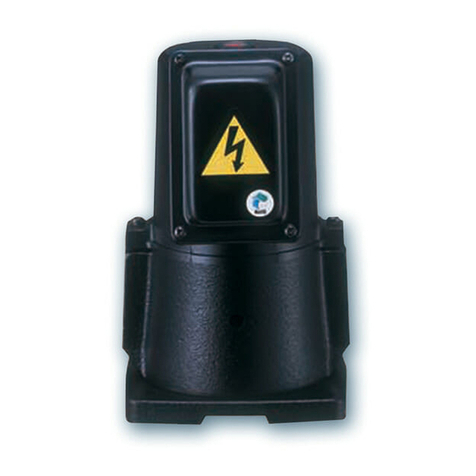
Teral
Teral VKN Series User manual

Teral
Teral LP User manual

Teral
Teral Patron SP-10 User manual
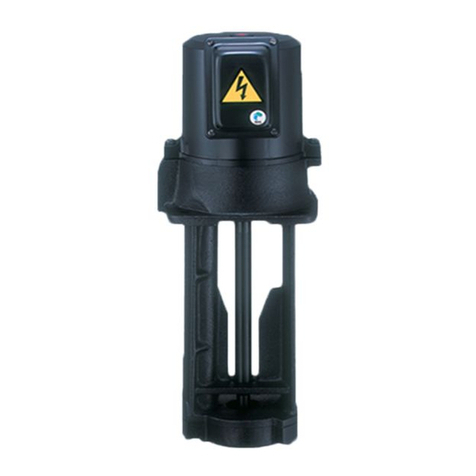
Teral
Teral VKN-e Series User manual
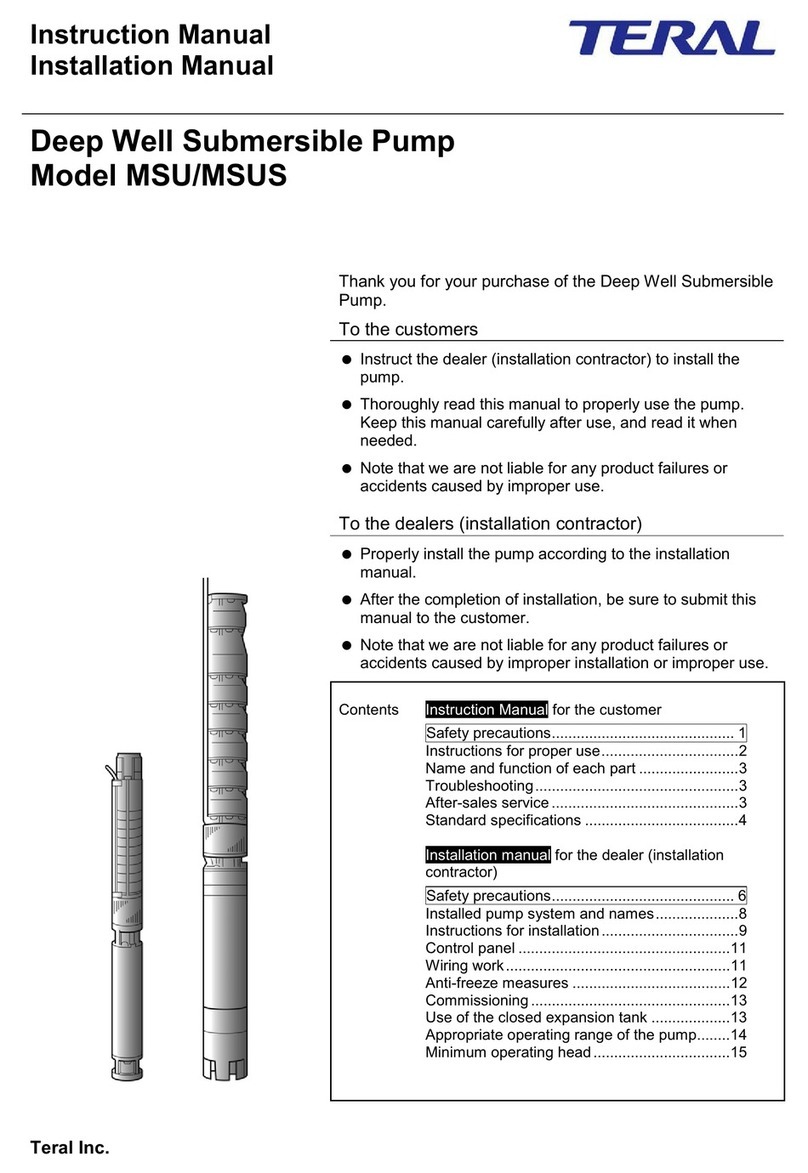
Teral
Teral MSU User manual

Teral
Teral NSVM Series Installation instructions
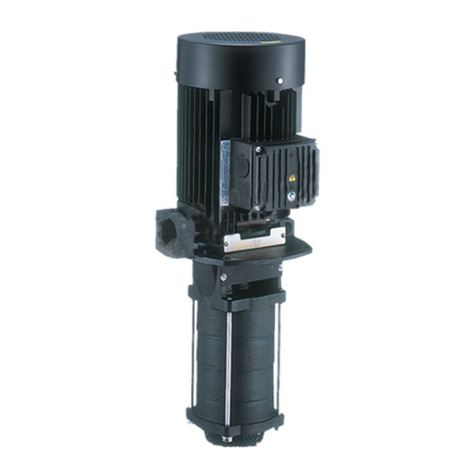
Teral
Teral VKD-e Series User manual

Teral
Teral LVS-e Series User manual
